Abstract
Macrophages are cytotoxic to chicken embryonic fibroblasts without either previous activation or lymphocyte assistance. This cytotoxic activity (xenolysis) is expressed by non-activated macrophages from athymic mice as well as by pure macrophage populations. Neither macrophage lysate nor supernatants of macrophages cultivated with fibroblasts cause xenolysis. Unlike macrophage tumoricidal activity, killing of xenogeneic cells is not dependent on specific serum factors and is expressed by macrophages from a lipopolysaccharide (LPS) unresponsive strain (C3H/HeJ). Xenolysis is expressed also by trypsin-treated macrophages and by macrophages from 5-day-old cultures. Killing of chicken fibroblasts by macrophages is not affected by hydrocortisone (100 micrograms/ml) gold salt (1 mg/ml) and colchicine (100 micrograms/ml). On the other hand, cytochalasin B (10 micrograms/ml) completely abolishes the killing, probably by interfering with macrophage mobility and extension of filopodia toward the targets. It is suggested that the xenolytic activity of macrophages represents a primitive trait of phagocytes which assists the body in defence against multicellular parasites.
Full text
PDF
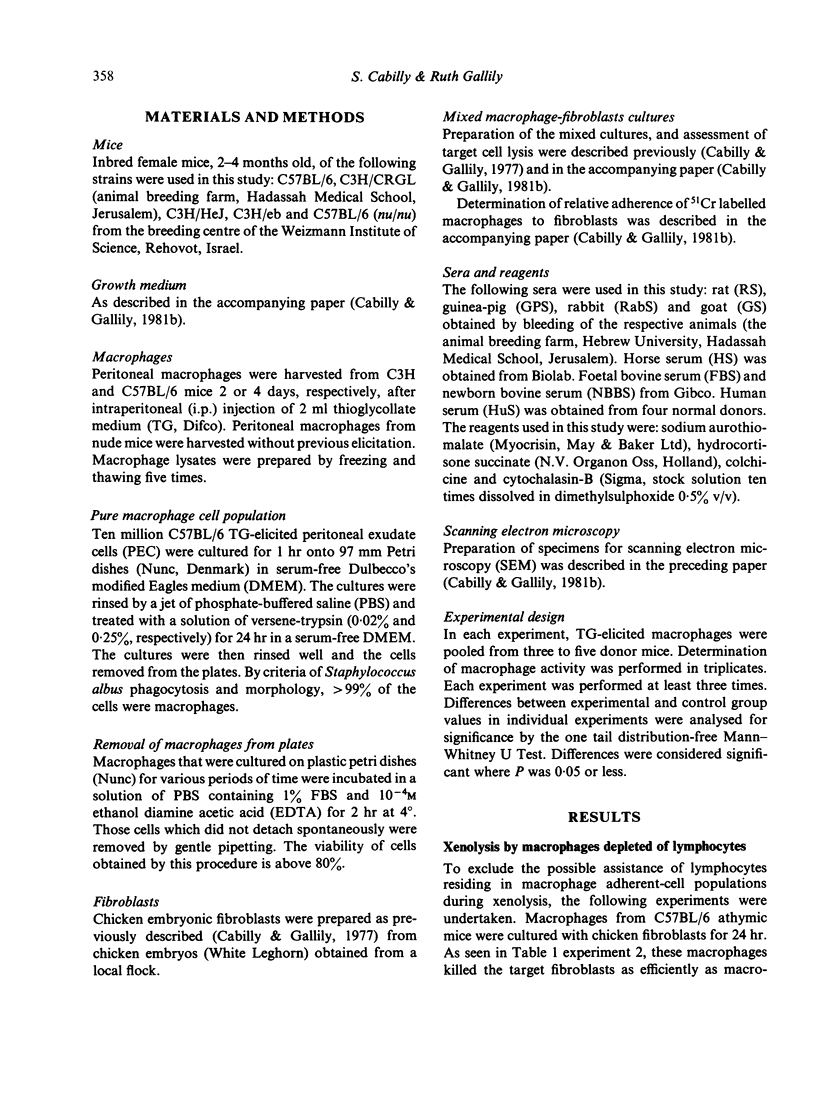
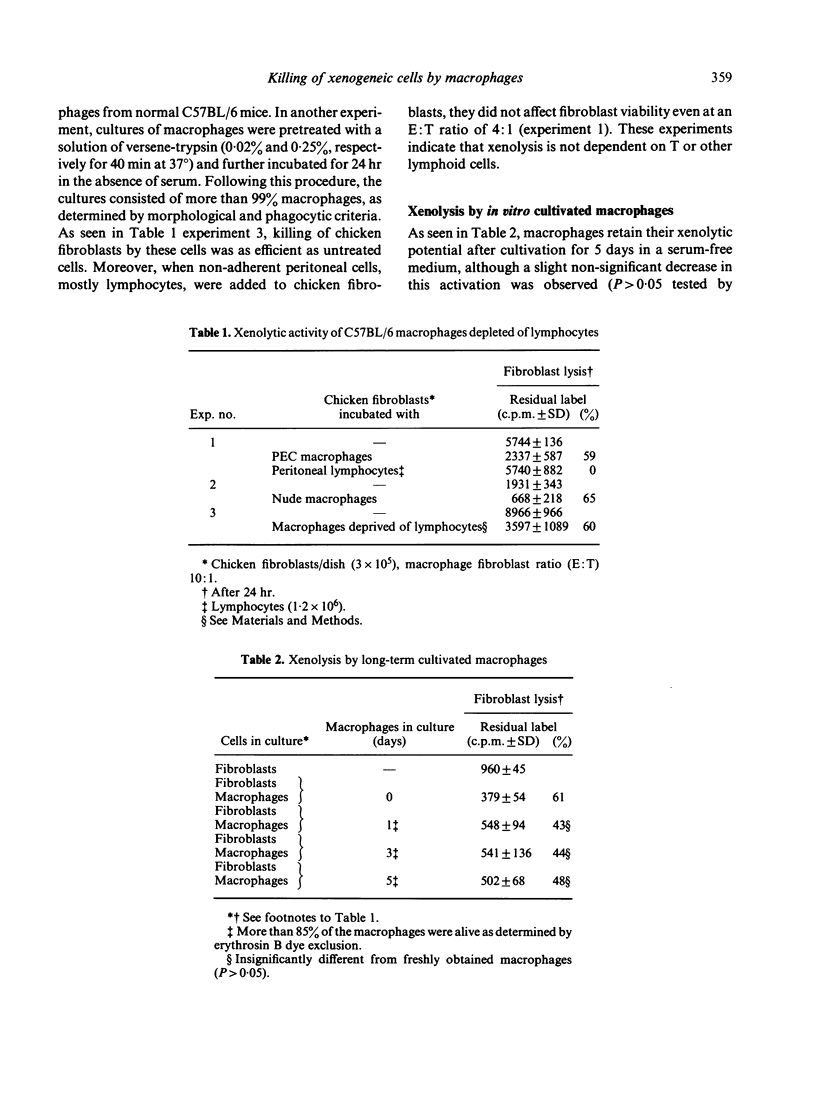
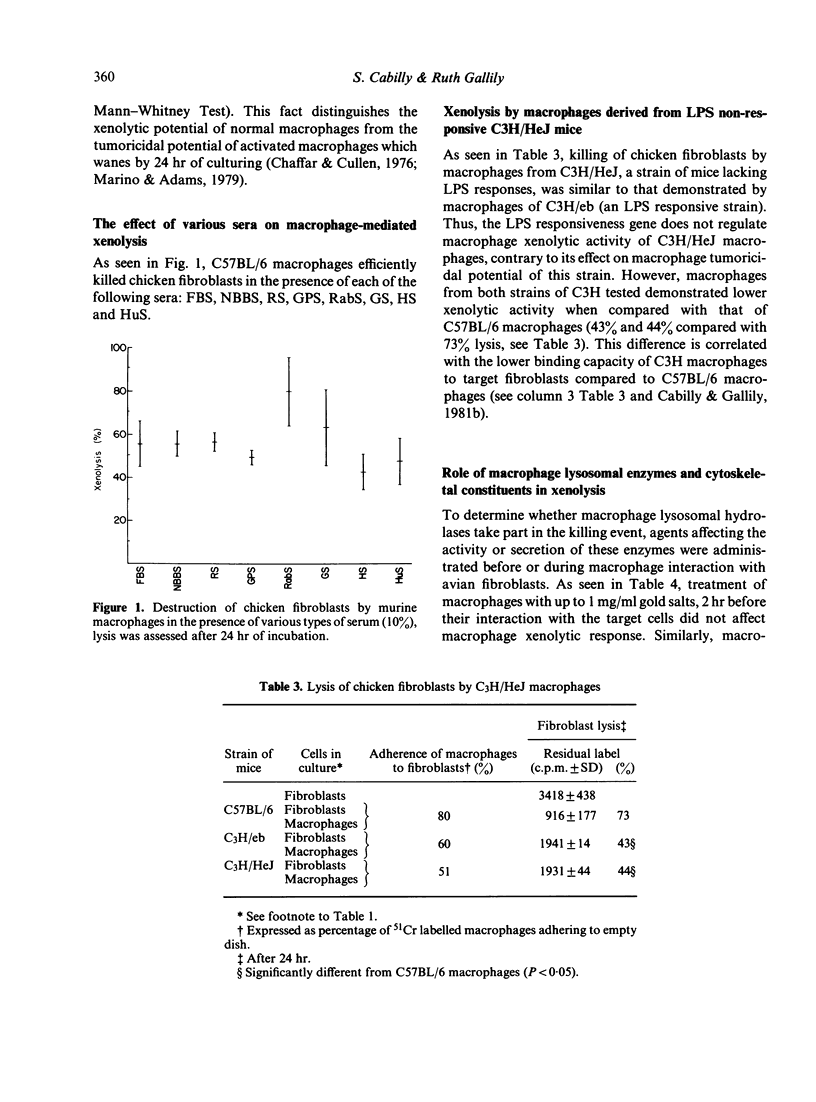
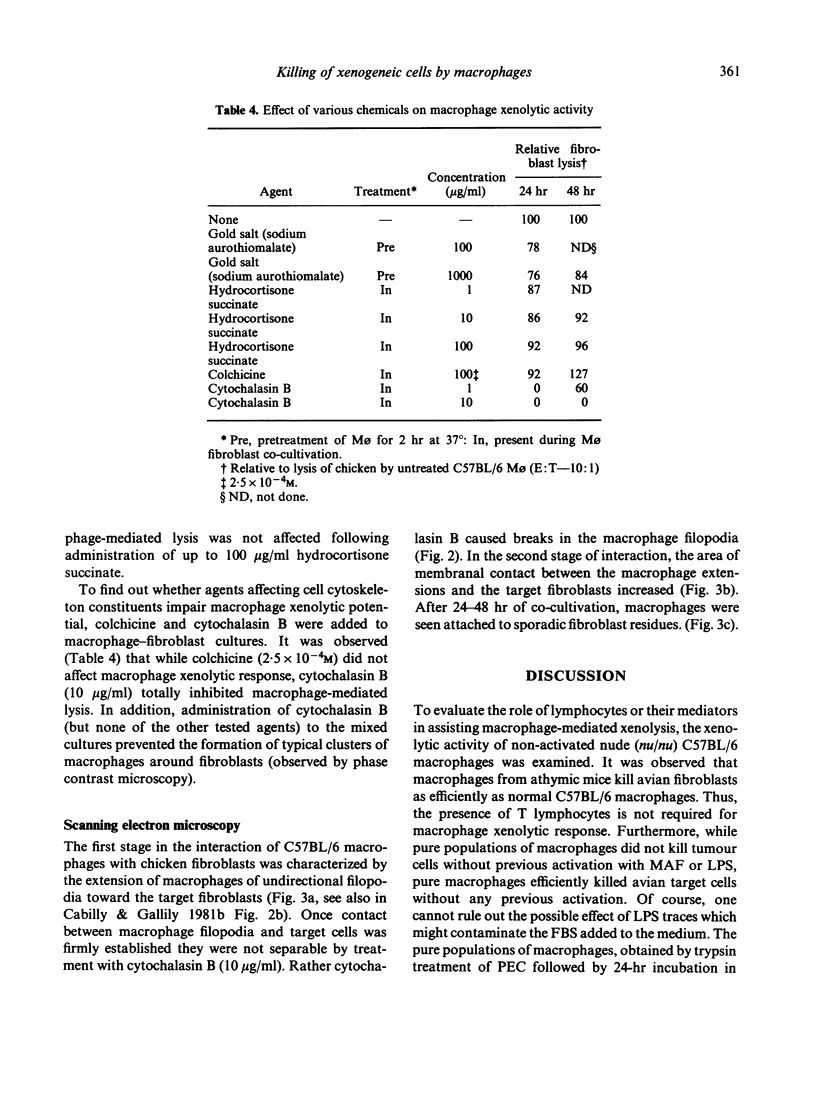
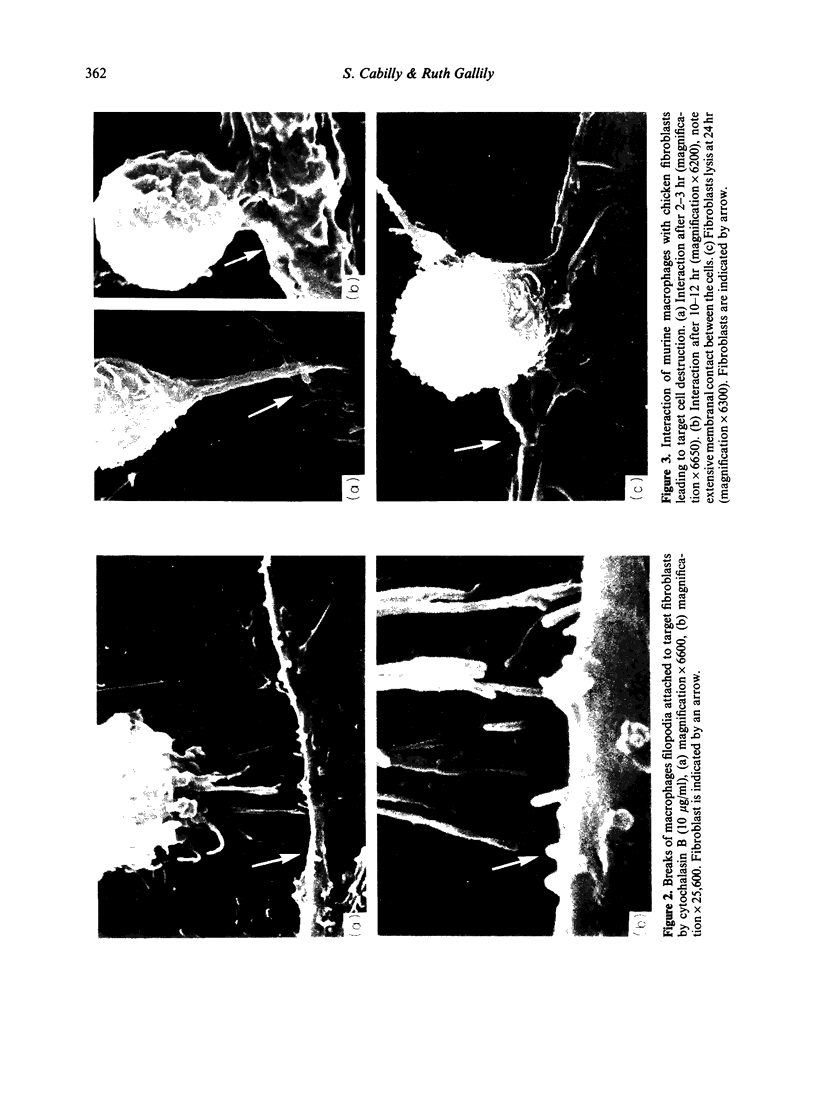

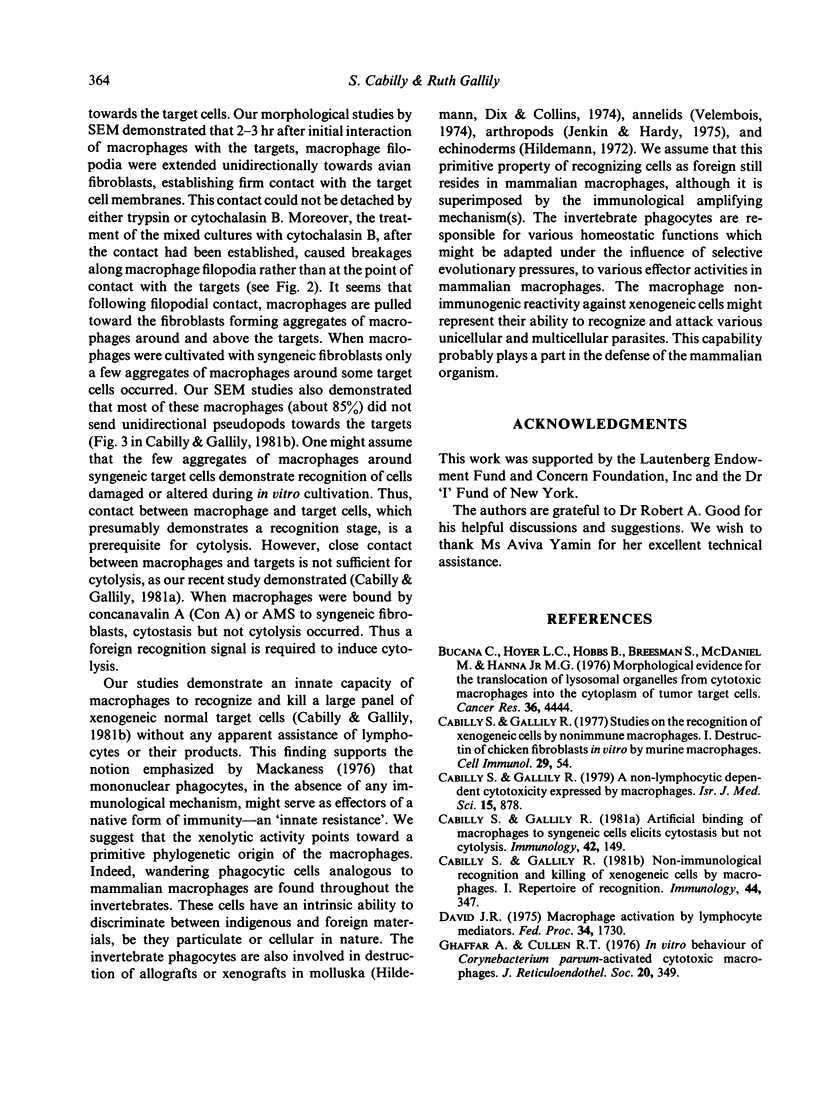

Images in this article
Selected References
These references are in PubMed. This may not be the complete list of references from this article.
- Bucana C., Hoyer L. C., Hobbs B., Breesman S., McDaniel M., Hanna M. G., Jr Morphological evidence for the translocation of lysosomal organelles from cytotoxic macrophages into the cytoplasm of tumor target cells. Cancer Res. 1976 Dec;36(12):4444–4458. [PubMed] [Google Scholar]
- Cabilly S., Gallily R. Artificial binding of macrophages to syngeneic cells elicits cytostasis but not cytolysis. Immunology. 1981 Jan;42(1):149–155. [PMC free article] [PubMed] [Google Scholar]
- Cabilly S., Gallily R. Non-immunological recognition and killing of xenogeneic cells by macrophages. I. Repertoire of recognition. Immunology. 1981 Oct;44(2):347–355. [PMC free article] [PubMed] [Google Scholar]
- Cabilly S., Gallily R. Studies on the recognition of xenogeneic cells by nonimmune macrophages. I. Destruction of chicken fibroblasts in vitro by murine macrophages. Cell Immunol. 1977 Mar 1;29(1):54–65. doi: 10.1016/0008-8749(77)90274-x. [DOI] [PubMed] [Google Scholar]
- David J. R. Macrophage activation by lymphocyte mediators. Fed Proc. 1975 Jul;34(8):1730–1736. [PubMed] [Google Scholar]
- Ghaffar A., Cullen R. T. In vitro behavior of Corynebacterium parvum-activated cytotoxic macrophages. J Reticuloendothel Soc. 1976 Nov;20(5):349–357. [PubMed] [Google Scholar]
- Ghaffar A., McBride W. H., Cullen R. T. Interaction of tumor cells and activated macrophages in vitro: modulation by Corynebacterium parvum and gold salt. J Reticuloendothel Soc. 1976 Oct;20(4):283–289. [PubMed] [Google Scholar]
- Hibbs J. B., Jr Heterocytolysis by macrophages activated by bacillus Calmette-Guérin: lysosome exocytosis into tumor cells. Science. 1974 Apr 26;184(4135):468–471. doi: 10.1126/science.184.4135.468. [DOI] [PubMed] [Google Scholar]
- Hibbs J. B., Jr, Taintor R. R., Chapman H. A., Jr, Weinberg J. B. Macrophage tumor killing: influence of the local environment. Science. 1977 Jul 15;197(4300):279–282. doi: 10.1126/science.327547. [DOI] [PubMed] [Google Scholar]
- Jenkin C. R., Hardy D. Recognition factors of the crayfish and the generation of diversity. Adv Exp Med Biol. 1975;64:55–65. doi: 10.1007/978-1-4684-3261-9_7. [DOI] [PubMed] [Google Scholar]
- Johnson K. J., Ward P. A., Goralnick S., Osborn M. J. Isolation from human serum of an inactivator of bacterial lipopolysaccharide. Am J Pathol. 1977 Sep;88(3):559–574. [PMC free article] [PubMed] [Google Scholar]
- McIvor K. L., Weiser R. S. Mechanisms of target cell destruction by alloimmune peritoneal macrophages. II. Release of a specific cytotoxin from interacting cells. Immunology. 1971 Mar;20(3):315–322. [PMC free article] [PubMed] [Google Scholar]
- Nathan C. F., Brukner L. H., Silverstein S. C., Cohn Z. A. Extracellular cytolysis by activated macrophages and granulocytes. I. Pharmacologic triggering of effector cells and the release of hydrogen peroxide. J Exp Med. 1979 Jan 1;149(1):84–99. doi: 10.1084/jem.149.1.84. [DOI] [PMC free article] [PubMed] [Google Scholar]
- Oroszlan S., McFarland V. W., Mora P. T., Shear M. J. Reversible inactivation of an endotoxin by plasma proteins. Ann N Y Acad Sci. 1966 Jun 30;133(2):622–628. doi: 10.1111/j.1749-6632.1966.tb52393.x. [DOI] [PubMed] [Google Scholar]
- Persellin R. H., Ziff M. The effect of gold salt on lysosomal enzymes of the peritoneal macrophage. Arthritis Rheum. 1966 Feb;9(1):57–65. doi: 10.1002/art.1780090107. [DOI] [PubMed] [Google Scholar]
- Ruco L. P., Meltzer M. S. Macrophage activation for tumor cytotoxicity: induction of tumoricidal macrophages by supernatants of PPD-stimulated Bacillus Calmette-Guérin-immune spleen cell cultures. J Immunol. 1977 Sep;119(3):889–896. [PubMed] [Google Scholar]
- Ruco L. P., Meltzer M. S., Rosenstreich D. L. Macrophage activation for tumor cytotoxicity: control of macrophage tumoricidal capacity by the LPS gene. J Immunol. 1978 Aug;121(2):543–548. [PubMed] [Google Scholar]
- Sharma S. D., Piessens W. F. Tumor cell killing by macrophages activated in vitro with lymphocyte mediators. III. Inhibition by cytochalasins, colchicine, and vinblastine. Cell Immunol. 1978 Jul;38(2):276–285. doi: 10.1016/0008-8749(78)90058-8. [DOI] [PubMed] [Google Scholar]
- VOL'-EPSHTEIN G. L. [Cyst of the thymus gland]. Grudn Khir. 1962 May-Jun;4:121–122. [PubMed] [Google Scholar]
- WEISSMANN G., DINGLE J. Release of lysosomal protease by ultraviolet irradiation and inhibition by hydrocortisone. Exp Cell Res. 1961 Oct;25:207–210. doi: 10.1016/0014-4827(61)90328-7. [DOI] [PubMed] [Google Scholar]




